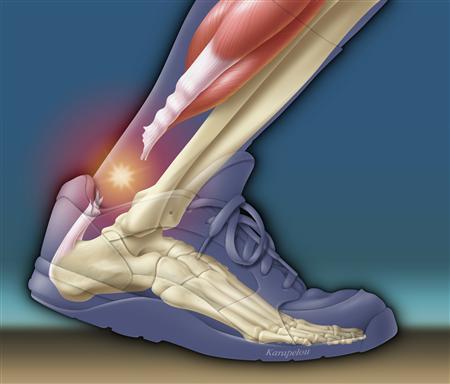tags: performance horses, polo, racing, tendon injury, stem cell research
Horses clear a jump during the Challenge Cup Handicap Steeplechase
on the second day of the Cheltenham Festival in the UK.
Image: BBC News.
Those of you who follow my writings about racehorses and other high-performance horses will be interested to learn that several companies that I've been following have been redirecting their stem-cell research that they originally developed to help injured horses to help people recover from Achilles tendon injuries.
After a tendon or ligament tear, both horses and people permanently lose mobility. This is because torn tendons and ligaments often lose strength when they heal because they develop scar tissue at the injury site. Scar tissue is fibrous and lacks the elasticity and strength of the original tendon tissue. However, stem cells circumvent this problem because they have the capacity to become a variety of different cell types, so they give rise to new tendon tissue instead of scar tissue at the site of the injury.
This new technology relies upon isolating stem cells taken from the bone marrow of an injured horse and culturing them in a laboratory. After these stem cells reach a high density, they, along with essential growth factors and an autologous scaffold, are then injected directly into the horse's damaged tendons or ligaments.
This technique has been used by the privately-owned British company, MedCell Bioscience, Ltd., to successfully treat injuries in more than 1500 horses so far. Follow-up data suggest these horses experience a 50% reduction in re-injury over a three year period when compared to conventionally treated horses.
For example, the British racehorse, Knowhere, has once again resumed his winning ways after being treated with stem cells for serious tendon injuries to his forelegs.
Other stem-cell treatment companies, such as Vet-Stem, show similar success rates for their horses.
Encouraged by these results in horses, this medical technique is being adapted for the treatment of Achilles tendinopathies in humans for the first time ever. According to MedCell, pilot studies will begin within the year and a larger confirmatory study is scheduled to begin at several European hospitals beginning in 2011.
"The move from clinical veterinary to human medicine is inspiring and unusual; we normally see the translation happening the other way around," said Nicola Maffulli, a sports medicine expert and orthopedic surgeon who will help conduct the trial.
An illustration of a complete tear (rupture) of the Achilles tendon, the strong tendon connecting the calf muscles of the leg to the heel bone, is shown in an athletic shoe.
Already, stem cell treatments are being designed for compressive spinal cord disease and laminitis, an inflammatory foot disease in horses as well as for bone fractures in both horses and humans, and for heart disease, diabetes, liver disease and spinal cord injuries in dogs.
"I am very excited to be involved in the human studies and hope that the results will herald a new era in the treatment of musculoskeletal soft tissue injuries," continued Dr. Maffulli. "At present the management of human tendinopathy is more an art than a science but this approach could potentially reverse that situation."
Sources:
VetCell Press Release.
Vet-Stem Press Release.
Reuters (Achilles tendon image).
BloodHorse reported case study.
Injured? Horsing Around With Stem Cells May Get You Back in the Saddle.
- Log in to post comments



Pardon me while avoid going PhysioProfic.
Having completely ruptured an Achilles tendon last year, this is (insert PP adjectives) awesome.
What an exciting and interesting post! Thanks for adding your posts to the upcoming May Carnival of the Horses :)
Hi, I am the mother of a 30 year old daughter who has had two spinal fusions, Lucy is beautiful, not only in looks but in character, very gentle.
The first fusion was not successful, the second fusion was done in Switzerland and was successful, however Lucy has much pain that is unbearable for her, as a mother I feel useless, the can only be kept under control by strong opiate drugs, which make Lucy fat and effect her personality.
The reason for the pain is the nerve damage from the first fusion and mainly the scar tissue that is growing around her spinal cord, will this stem cell treatment help my lovely daughter? If anyone knows of a stem cell cure for this Please please get in touch with me. On the other hand please do not be so unkind as to raise our hopes in order to financially benefit, I have spent my all my savings on trying to make Lucy's life easier, it has all been to no avail so far.